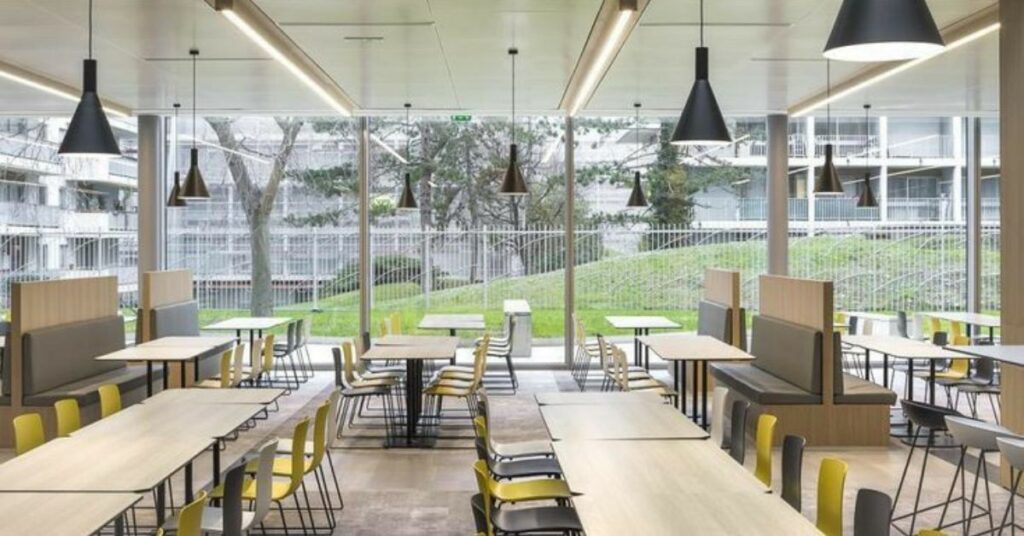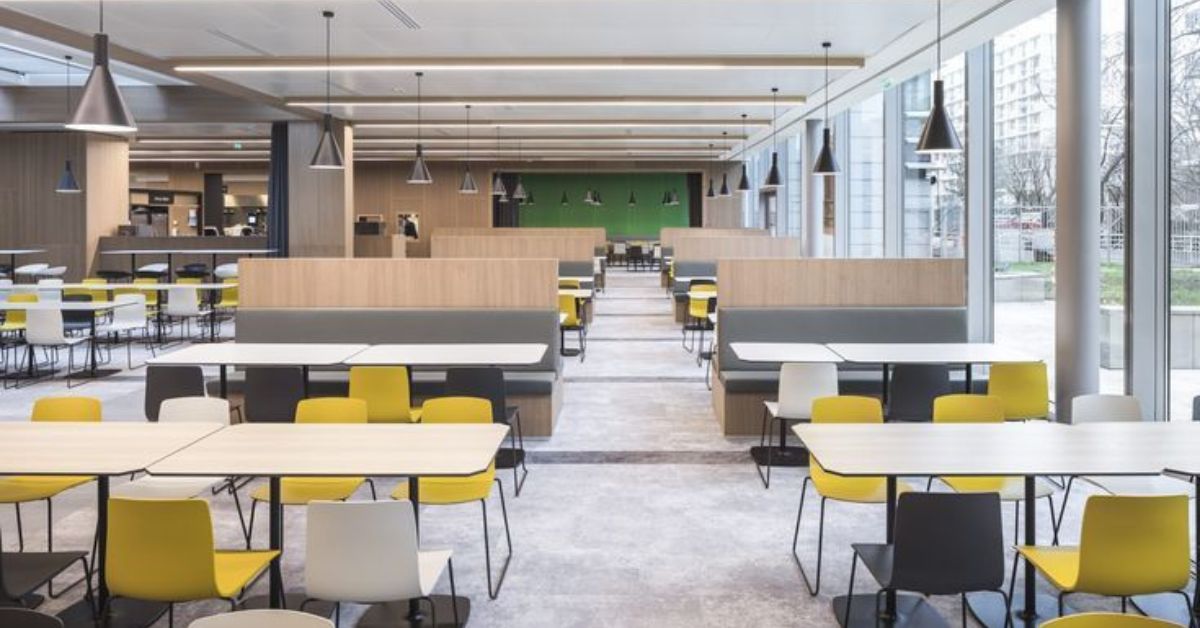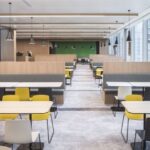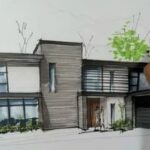A well-designed cafeteria is more than just a place to eat—it’s a space that fosters community, encourages relaxation, and enhances the overall dining experience.
Cafeteria design influences how people interact, dine, and feel within the space, whether in a school, office, hospital, or public setting.
From layout to aesthetics and functionality, incorporating thoughtful design concepts can transform any cafeteria into a vibrant, efficient, and welcoming environment.
Key Elements of Effective Cafeteria Design
1: Functionality and Flow
The primary goal of any cafeteria is to serve food efficiently while maintaining a comfortable traffic flow. The layout should be intuitive, with clearly defined zones for queuing, food selection, payment, and seating. Minimizing bottlenecks and ensuring smooth movement can significantly enhance the dining experience.
2: Comfortable and Flexible Seating
Seating arrangements should accommodate different group sizes and preferences. Mix long communal tables with smaller, more private seating options to cater to social diners and those seeking quiet. Comfortable chairs and ergonomic designs are essential for encouraging more extended stays.
3: Aesthetics and Atmosphere
The visual appeal of a cafeteria sets the tone for the dining experience. Use a cohesive colour palette, attractive materials, and thoughtful lighting to create an inviting ambience. Natural light, when possible, enhances the space and contributes to a pleasant environment.
4: Acoustic Considerations
Cafeterias can be noisy, especially in large spaces. To minimize noise levels and create a more enjoyable atmosphere, incorporate acoustic panels, soft furnishings, and strategic layout choices.
5: Sustainability and Eco-Friendly Design
Incorporating sustainable materials and energy-efficient lighting benefits the environment and aligns with modern values. To create an eco-friendly cafeteria, use recycled materials, energy-efficient appliances, and waste-reduction strategies.
6: Technology Integration
Digital menus, self-service kiosks, and mobile ordering options can benefit modern cafeterias. These innovations improve efficiency and cater to tech-savvy users.
Popular Cafeteria Design Concepts
1: Open-Plan Design
An open-plan layout creates a sense of spaciousness and allows for flexible seating arrangements. It encourages interaction and makes the space less confined, ideal for schools, offices, and public areas.
2: Food Court Style
This concept divides the cafeteria into multiple food stations or counters, each offering different cuisines or food types. It provides variety and reduces wait times, making it a popular choice for large-scale cafeterias like those in malls, universities, or corporate campuses.
3: Minimalist Design
A minimalist approach focuses on clean lines, neutral colours, and uncluttered spaces. This design is modern and calming, perfect for professional environments like corporate offices or healthcare facilities.
4: Industrial Chic
Exposed brick walls, metal fixtures, and raw materials give cafeterias an edgy, contemporary look. This design works well in urban settings, creative workspaces, or trendy public areas.
5: Biophilic Design
Incorporating natural elements like indoor plants, green walls, and wooden finishes connects diners with nature, enhancing well-being and creating a relaxing environment. This is ideal for schools, wellness centres, and eco-conscious organizations.
6: Café-Inspired Design
This design concept mimics a coffee shop’s cosy, intimate feel. It uses warm lighting, comfortable seating, and stylish décor to create a more relaxed and social atmosphere. It is perfect for smaller cafeterias or breakout areas in offices.
Design Considerations for Different Types of Cafeterias
School Cafeterias
- Durability: Use materials that can withstand heavy use and are easy to clean.
- Vibrant Colors: Bright, cheerful colours create a welcoming environment for students.
- Flexible Seating: Accommodate large groups and individual seating to cater to various student needs.
- Safety: Rounded corners on tables and slip-resistant flooring are essential for student safety.
Corporate Cafeterias
- Modern Aesthetics: Sleek, professional designs that reflect the company’s brand identity.
- Breakout Spaces: Include areas for informal meetings, collaboration, or solo work during lunch breaks.
- Healthy Choices: Design food stations highlighting healthy eating options and promoting wellness.
Hospital and Healthcare Cafeterias

- Calming Environment: Use soothing colours, natural light, and comfortable seating to create a relaxing space for patients, visitors, and staff.
- Accessibility: Ensure the space is accessible to all, including those with mobility challenges.
- Hygienic Design: Emphasize cleanliness with easy-to-sanitize surfaces and well-organized food stations.
Public and Community Cafeterias
- Inclusive Design: Create a welcoming space accommodating diverse groups, including families, seniors, and individuals.
- Multi-Functional Spaces: Design the cafeteria as a community gathering area for events, meetings, or workshops.
- Affordable and Efficient: Focus on cost-effective materials without compromising aesthetics and functionality.
Innovative Cafeteria Design Trends
- Sustainable Materials and Green Initiatives
- Eco-friendly cafeterias are on the rise. Using reclaimed wood, recycled metal, and energy-efficient lighting helps reduce the environmental impact. Composting stations, reusable dishware, and water-saving appliances are also becoming standard.
- Modular and Moveable Furniture
- Many cafeterias now use modular furniture that can be easily rearranged for different events or group sizes to maximize flexibility. This approach is perfect for multi-use spaces.
- Interactive Food Stations
- Open kitchens or live cooking stations allow diners to see their food being prepared, adding an element of transparency and engagement. This trend is prevalent in corporate and high-end public cafeterias.
- Smart Technology Integration
- From touchless payment systems to app-based ordering and even AI-powered menu recommendations, technology is revolutionizing the cafeteria experience. Digital screens for menus and nutritional information also enhance convenience.
- Global and Diverse Cuisines
- Reflecting cultural diversity, many cafeterias now offer a range of international cuisines. The design can complement this by creating themed sections or incorporating cultural decor elements.
Final Thoughts
A thoughtfully designed cafeteria does more than serve meals—it creates a space where people can relax, connect, and recharge.
By balancing aesthetics, functionality, and sustainability, you can design a cafeteria that meets the needs of its users while offering a welcoming and enjoyable dining experience.
Whether you’re planning for a school, office, hospital, or public space, the right design concepts can transform a simple cafeteria into the heart of the community.
Latest Posts!












